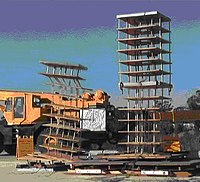
Photo from wikipedia
Abstract Many Coulomb friction-based devices have been used for seismic isolation of modern civil structures. Aiming at a practical problem that if the friction action could be scaled in a… Click to show full abstract
Abstract Many Coulomb friction-based devices have been used for seismic isolation of modern civil structures. Aiming at a practical problem that if the friction action could be scaled in a shaking table model test, a base isolation system using Coulomb friction was numerically scaled in different ways by considering the gravity distortion, friction distribution and other influence factors. The seismic responses back calculated from the scaled models were compared with those of the full-scale model to evaluate the accuracy of scale theory for such a Coulomb friction action. The above numerical results show that the scale theory is still applicable for the uniform and non-uniform friction distribution patterns with nonlinear characteristics. The gravity distortion and uneven friction distribution are the most important factors, causing the errors of scale theory for the Coulomb friction system. However, the unallowable errors, caused by the un-scaled gravity acceleration on common shaking tables, can be avoided by reasonably changing the friction coefficients at the scaled friction interface. And other unallowable errors, caused by the uneven friction distribution, can be prevented if the specific positions with different friction coefficients for the full-scale model are proportionally moved with the scaled contact surface.
Journal Title: International Journal of Non-linear Mechanics
Year Published: 2018
Link to full text (if available)
Share on Social Media: Sign Up to like & get
recommendations!